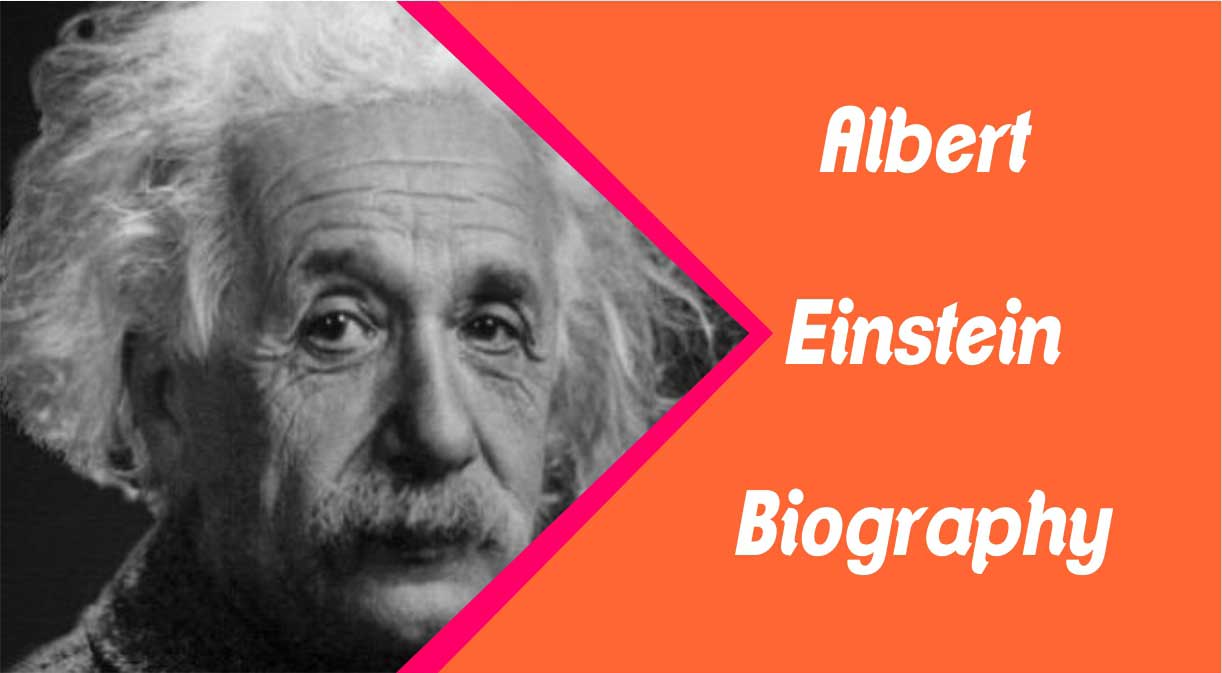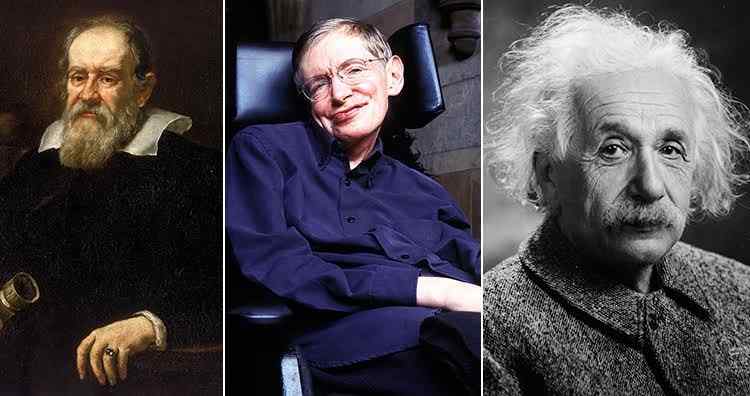
Albert Einstein Biography and Facts
Before we proceed to read biography of Albert Einstein, here is a fun fact for you: Birthday of Stephen Hawking = Death day of Galileo Galilei (i.e. 8 Jan) & death day of Stephen Hawking = birthday of Albert Einstein (i.e. 14 march).

so let's start-
Probably heard of Albert Einstein, an outstanding scientist of the 20th century, and knows what he looked like: disheveled blond hair and a colorful “looking” mustache.
All modern physics is based on the discoveries of this man. He built a model of space and time, explained how stars shine and how electric motors work. At the same time, Einstein refuted the scientific ideas that were widespread in the nineteenth century.
Who was this great man and what particular discoveries belong to him?
Who is Albert Einstein?
Albert Einstein was born in Ulm, Germany in 1879, the son of an owner of a company that sells electrical equipment. Many people know that in childhood, Albert developed much slower than his peers and only at the age of seven began to speak normally. He probably had some form of autism. His mother even considered him inferior because of his too big head.
At the same time, at the age of five, Albert first showed an interest in science. The father showed him the compass, and the child was amazed that the arrow was pointing in one direction all the time, and wondered what kind of force was driving it.
The boy did not like school. Although, they say, the fact that he was a poor student is still a myth. Einstein preferred self-education to lessons. He adored exact sciences (at the age of 15 he had already mastered differential calculus), reading and the violin, which he carried with him all his life. Playing the violin has always helped him both to relax and, conversely, to solve complex problems.
At first, Albert Einstein studied at a Catholic school, and then at a gymnasium, which he never graduated from. But he told his parents that without this he would enter the Zurich Higher Technical School (Polytechnic). However, Albert passed only mathematics and physics perfectly, and “failed” the rest of the subjects. Then he still managed to enter this educational institution, but he constantly skipped classes even here. But he was keenly interested in scientific theories outside of school and read a lot about them in magazines.
At the Polytechnic, Einstein met the mathematician Grossman, who later helped him get a job at the Berne Federal Office for Patent Inventions. Albert Einstein worked there for seven years. In parallel, he began to write annotations of texts on thermodynamics (a branch of physics that studies heat and its transformation into other forms of energy). The main work did not fascinate Einstein too much, but left time for scientific activity.
Einstein published his first article at the age of 22. And his most famous discovery – the special theory of relativity – was published four years later, in 1905. At first, the work did not particularly attract the scientific community. Fame came to Einstein gradually. Who would have thought then that a simple employee of the bureau had about 300 scientific papers and about 150 books and articles in various fields ahead!
Having already gained fame in scientific circles, Einstein was actively involved in teaching. In 1909 he was invited to become a professor at the University of Zurich, two years later – the head of the physics department at the German University in Prague, and a year later he began teaching at his native polytechnic. Then the scientist headed the Berlin Physics Research Institute.
Albert Einstein had no doubt that he would receive the Nobel Prize for the theory of relativity – he even agreed with his first wife upon divorce that he would give the money to her. The scientist was first nominated in 1910, and subsequently this happened almost every year. But in the end, he received the award only 12 years later, and even not personally – he was away. The point is that the Nobel committee doubted Einstein’s bold theory. He eventually won the prize for another theory – the photoelectric effect.
Few people know that Einstein invented his refrigerator and even sold a patent for an invention to a large company. It began with the fact that he read in the newspaper about the death of an entire family due to the leakage of harmful sulfur dioxide from a broken refrigerator. Albert Einstein and a former student decided to create a refrigerator with a safer mechanism of action. Alas, it never entered production, because it was at that time that another design of refrigeration units, a compressor, became widespread. Moreover, it is not known where the only “Einstein’s refrigerator” went – it has survived only in photographs.
Albert Einstein lived 76 years (until 1955), was married twice, had three children. For the last 15 years he has lived and worked in the United States. After his death, pathologist Thomas Harvey removed the scientist’s brain, photographed it from various angles, cut it into pieces and sent it to different laboratories around the world for many years. According to some reports, Einstein himself insisted that his brain be examined posthumously, but according to others, permission was given by his son after the fact, and during the autopsy, the pathologist actually simply stole the brain.
This body has become the subject of more than one scientific study. Experts found that the areas of Einstein’s brain responsible for speech are reduced, and those for processing numerical and spatial information are enlarged. One study says that this brain was 170 grams smaller than the average brain of a 76-year-old man, and another that Einstein’s brain is 15% wider than the average.
The most important discoveries of Einstein
1. The theory of the photoelectric effect (1905)
Before Einstein, it was believed that light propagates in the form of waves. He also first considered light in the form of tiny particles, or portions of energy. Later, the theory was developed by the scientist Max Planck.
2. Explaining Brownian Motion (1905)
Brownian motion is the random movement of tiny particles (such as dust particles) in water that can be seen under a microscope. Einstein proved that dust particles move randomly due to collisions with moving atoms. Thus, he proved the existence of atoms (the smallest chemically indivisible particles of a substance) and molecules (the smallest particles of a substance that have all of its basic chemical properties; a molecule can consist of one or more atoms).
3. Special theory of relativity (1905)
Special theory of relativity describes space and time in a way unique for that time. They say that Albert Einstein came up with the theory when he was riding a tram and looked at the clock post. The scientist noted that if you imagine that the tram will accelerate to the speed of light, the clock will stop for it.
Einstein put forward the theory that time and distance may not be constant – these are relative concepts. When two objects are moving at a constant speed, you need to consider their movement relative to each other. That is, for example, if you and your friend were flying on two spaceships, in order to compare your observations, you would need to know your speed of movement relative to each other.
The scientist proceeded from the fact that the speed of light – 299 792 458 meters per second – is unchanged and cannot be surpassed. If the speed of light could be surpassed by acceleration, it would be possible to build a time machine and travel anywhere. As we all know, speed is the distance covered in a given period of time. Since the speed of light does not change, time and distance must change.
Einstein demonstrated that for objects that move at the speed of light, time stretches and flows more slowly, while distances are reduced. These objects themselves become heavy.
From the last statement, Einstein then derived the famous equation: energy is equal to the mass of an object multiplied by the speed of light squared. It is not necessary to delve into the meaning of this equation – it is enough to understand how the scientist reasoned. Since the mass of an object grows as its speed approaches the speed of light, in order to gain this mass and not reduce the speed, additional energy is needed. That is, mass and energy are interchangeable. This theory explains the effect of radiation: mass turns into energy.
Einstein’s special theory of relativity was then used to create the atomic bomb.
4. General theory of relativity (1915–1916)
If the special theory of relativity considers only the case of rectilinear and uniform motion, then the general theory explains the motion of a body, even when it accelerates or collapses.
This theory first explained why planets revolve around the sun. It turned out because space and time around him are distorted.
Einstein found that gravity is a distortion in space and time. The higher the mass of the object, the greater the distortion.
The scientist imagined a beam of light that penetrates the falling elevator. The beam will reach the far wall of the elevator slightly higher than the front, because the elevator falls and the beam bends slightly upward. Does it really bend? Einstein suggested that this is an illusion that is created because the force pulling the elevator downward distorts time and space.
Explaining the general theory of relativity, such an example is sometimes given. A heavy object – say a kettlebell – makes a dent in the rubber mat. This is how gravity distorts space and time. Any object passing slowly in the vicinity rolls into the dent and moves inside it. A body that moves faster will follow an open path around the weight, while a light beam moving faster and more distant will bend slightly.
Many scientists have questioned Einstein’s theory. Then he figured out how to prove his case. He asked astronomers to record the shift (relative to the observer) in the position of a distant star as it passes near the Sun. This shift would demonstrate that the beams of starlight were bent because space and time near the Sun were distorted. In 1919, after waiting for a solar eclipse, when the stars can be observed near the Sun, expeditions went to Brazil and Guinea. Astronomers indeed recorded in the images that the star has significantly shifted relative to the Sun.
How Einstein Became Famous
If you don’t understand much about Einstein’s theory, don’t despair – even in its simplest form, it really sounds pretty tricky. Only a few of Einstein’s contemporaries understood it. There are a couple of funny stories about this.
Astrophysicist Arthur Eddington, who led those same expeditions to Guinea and Brazil, defended Einstein’s ideas. But once, when the scientist Ludwig Silverstein noticed that on earth, perhaps, only three people understand the general theory of relativity (meaning Einstein, Silverstein himself and Eddington), the astrophysicist replied: “I wonder who is the third?”
There is also an anecdotal case of Einstein’s correspondence with Charlie Chaplin. After the release of the silent comedy “Gold Rush” (1925) with a comedian in the title role, the scientist wrote him a letter, where he admired his film, which is “understandable to the whole world,” and predicted that Chaplin “would become a great man.” The comedian’s response was, “I admire you even more! Your theory of relativity is incomprehensible to anyone in the world, and you still became a great person. “
Indeed, after the publication of the results of observations by astronomers around the world, Einstein woke up famous. He, a rather reserved person, always treated his fame with restraint – he had no “star fever”. Moreover, he contrived to use popularity in the interests of those in need: for some time he took a dollar from everyone who wanted to get his autograph and donated what he collected to charity. True, sometimes he brushed off his fans with the phrase: “I am constantly confused with Einstein!”
It is not for nothing that they say that ideas are in the air: it is known that the German mathematician David Hilbert was working on a similarity to the theory of relativity almost simultaneously with Einstein. Scientists even actively corresponded on this matter – and practically at the same time, albeit in different ways, they derived the final equations. It was long believed that Hilbert had arrived at the same conclusions five days earlier than Einstein, but was slightly late in publishing them. But in 1997, thanks to the discovered documents, it turned out that there were many gaps in Hilbert’s theory, which were eliminated only after the publication of the publication of his colleague Einstein. Scientists, however, have never argued on this topic.
There is a version that Einstein achieved world success because he was one of the few physicists of his time who put experiments above theory. During this period, it was rather accepted to consider an experiment to be erroneous if it does not confirm the generally accepted theory. Einstein has a funny saying: “Theory is when everything is known, but nothing works. Practice – when everything works, but no one knows why. We combine theory and practice: nothing works, and no one knows why. “
Einstein dreamed of creating a unified theory in which, with the help of one equation, he would explain how everything in the world works – from small particles to galaxies, and worked on this until his death. But in the end, for some reason, he himself destroyed his work. Nobody saw him.
How we use Einstein’s discoveries in everyday life
You might think that Einstein’s theories are important and interesting only to theoretical scientists and do not affect everyday life in any way. But it is not so. For example, we use GPS navigators in our phone, determining our location and plotting the desired route. Such navigators are also found in cars. However, if their creators ignored the theory of relativity, the sensor readings would be inaccurate.
Why? The basis of the GPS system is 24 satellites that move above the Earth’s surface. Each satellite has an atomic-powered clock that keeps track of the time with high precision. Therefore, the simplest GPS receiver determines where we are in a few seconds. But satellites are located at a great distance from the earth, where the concepts of space and time are not the same as on the planet. In addition, since the probes (sensors) are in motion, it seems to us from the surface of the planet that the clock is running slower. According to both theories of relativity, clocks in orbit should be ahead of clocks on earth by 38 microseconds per day.
It would seem a trifle, but if it were not taken into account, the readings of the sensors would change at a speed of 10 kilometers per day. And what kind of GPS accuracy could we talk about?
Interesting facts about Albert Einstein
- Most of the time, the scientist was calm and cheerful. He believed that troubles “dissolve” from jokes, had a wonderful sense of humor and did not take adversity to heart. Even in anticipation of his own death, he was calm and complacent and refused the operation, seeing no reason to “artificially prolong his life.”
- Of sports, Einstein loved only swimming, which, in his opinion, required the least energy. As you can see, he preferred mental work to muscles.
- The great physicist hated science fiction and recommended not reading it, so as not to cultivate in himself a false scientific understanding. He said that he did not think about the future – anyway it would come soon.
- The well-known photo of Einstein showing his tongue was taken on the eve of his 72nd birthday. The scientist made this funny grimace when he was asked to smile, and he was already tired of cameras. Then, signing someone one of those pictures, Einstein joked that his gesture was “addressed to all of humanity.”
- For some reason, Albert Einstein did not wear socks. Even for special occasions.
- The outstanding scientist was extremely absent-minded. Once, having met a friend on the street, he invited him for tea, warning that Professor Stimson would be his guest. The interlocutor recalled with amazement that he was Stimson. “All the more so – come,” was the answer. And one day Einstein received a check for a large sum from one fund and used it as a bookmark for a book. And I… lost the book.
- Albert Einstein loved the books of Leo Tolstoy and Fyodor Dostoevsky.
- The face of Yoda from Star Wars was copied from images of Einstein and his facial expressions were used to create the character.
- Einstein’s wife said: “My husband is a genius – he knows how to do everything except money.”
Albert Einstein’s famous quotes:
- “Do you think everything is that simple? Yes, it’s simple. But not at all. ”
- “ There are only two infinite things: the Universe and stupidity. Although I’m not sure about the universe “
- ” Only a fool needs order – genius dominates chaos “
- ” Through coincidences, God maintains anonymity “
- ” The only thing that prevents me from learning is the education I received. “
Related Articales
Recently Posted
-
भगवान गौतम बुद्ध जीवन परिचय | Gautam Buddha in Hindi
December 15, 2022. -
कार्बन के अपररूप Allotropes of Carbon in Hindi
November 5, 2022. -
मिश्र धातु किसे कहते हैं? उपयोग, नाम, गुण Alloy in Hindi
July 27, 2022. -
गलनांक किसे कहते हैं? परिभाषा, उदाहरण Melting Point in Hindi
July 20, 2022. -
परिमाप किसे कहते हैं? Perimeter in Hindi
July 19, 2022.




